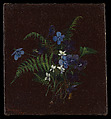Still Life
Fidelia Bridges American
Bridges is one of the few American women who became a prominent professional artist during the Civil War years. Celebrated then and now for her meticulous, naturalistic depictions of flora and fauna, she developed her own distinctive approach to capturing quiet moments in nature. Bridges, a student of William Trost Richards at the Pennsylvania Academy of the Fine Arts, embraced his Ruskinian ‘truth to nature’ approach to great effect—first in oil, then, increasingly, in watercolor, a medium in which she came to specialize over a successful and prolific fifty-year career.
Bridges’ oil paintings are far rarer than her watercolors, and mostly date to the 1860s. This example, from 1870, marks a transitional moment in her career, as she would soon turn to watercolor almost exclusively. The oil’s freshness—the seemingly just-picked violets and ferns bear a trace of brown earth—exemplifies Bridges’ commitment to depicting natural elements with immediacy and intimacy, what Richards described as ‘the voice of nature speaking in the idiom of art.’
Due to rights restrictions, this image cannot be enlarged, viewed at full screen, or downloaded.

